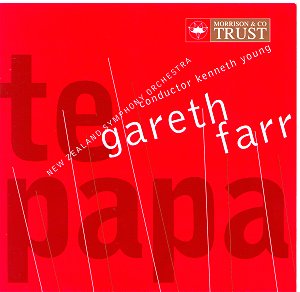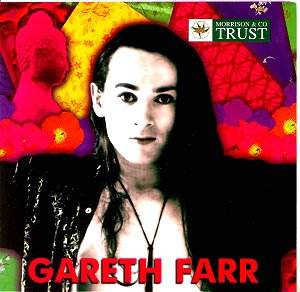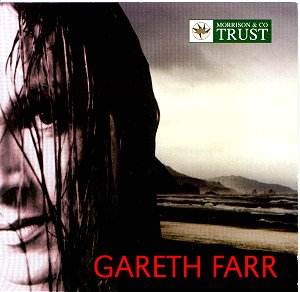There are 3 CDs considered
in this review
GARETH
FARR
Te Papa
Three versions of Te Papa: (1)
with full orchestra; (2) log drum'n'bass
mix; (3) urenui mix
 New Zealand SO/Kenneth Young
New Zealand SO/Kenneth Young
 CD
SINGLE MORRISON & CO MUSIC TRUST
MMT 2026 [19.25]
CD
SINGLE MORRISON & CO MUSIC TRUST
MMT 2026 [19.25]

Gareth Farr (b. 29 Feb
1968) is a composer and percussionist
born in Wellington, New Zealand. He
has studied composition, orchestration
and electronic music and has an M.Mus
from the Eastman School of Music. He
has performed with many world class
orchestras including with the LSO under
Leonard Bernstein. In addition he has
performed with Indonesian Gamelan ensembles.
He has also worked as a professional
drag artist in Rochester, New York,
and New Zealand.
In this CD single we
get three different 'takes' on Farr's
piece Te Papa (our place). The
first is the full orchestral version.
Over a thunder of drums an ecstatic
Hadley-like line is sung by tenor and
soprano- a setting from Charm
- an anonymous New Zealand Poem. This
music is suggestive of a sort of Maori
Song of the High Hills (Delius)
though more earthy - not so ethereal.
The collision of cultures (wild Maori
cries meshing with the English choral
tradition) works far better than I would
have guessed. There is plenty of visceral
excitement on offer. Te Papa seems to
protest a world in turmoil and the movement
of great tectonic plates. There is a
touch of Orff about this music: simple
but magnificent. The first two versions
are exciting. The third version involves
a 'funky' 1970s disco-beat underpinning
the Maori strangeness with burbles and
gurgles - not completely dismal but
pretty bad! Stick with the other two
tracks.
Reviewer
Rob Barnett

GARETH
FARR - orchestral
music
From the depths sound the great
sea gongs (1996)
Waipoua (1994)
Le temps est à la pluie
(1995)
Tabuh Pacific (1995)
Queen of Demons (1997)
 New Zealand SO / Gary Farr
New Zealand SO / Gary Farr
 MORRISON AND CO MUSIC TRUST MMT2021
[68.15]
MORRISON AND CO MUSIC TRUST MMT2021
[68.15]

From the depths
is in two sections. The first - The
Invocation of the Sea - pummels
us with the drums of Rarotonga, caresses
the ears with Balinese gamelan tintinnabulation
and soothes with the fragility of the
Japanese Taiko. The hammered pummelling
of the drums and the muscular celerity
of the Hakas of Aotearoa mingle with
Holst's Jupiter and Copland's
El Salon Mexico. Farr is a sculptor
of big sounds. The marine flicker of
E J Moeran's Symphony, the eruptive
upwards strike of geysers, Messiaen's
Turangalila and Ravel's wind writing
are encountered as we move through the
piece. The second, Thus Spake the
Sea Gongs, is gamelan-dominated
with wind playing fitfully around the
gamelan 'carpet'. Then, Hovhaness-like,
the great gongs arise and shake before
falling back into the sea amid a bleak
Sibelian threnody for strings. The music
peals in string terraces replete with
the stony authority of Shostakovich.
This is music in a mildly avant-garde
casing - a bit episodic but rising at
the end to a major statement - sappy,
joyous and with the stamp of Leonard
Bernstein.
Bruised and battered
after the first piece we are thankful
for the drowsy Finzian Waipoua
with Mary Scott's balm-laden
solo clarinet. The instrument just can't
help being lyrical and healing. This
would make an easy 'hit' on Classic
Fm.
Le Temps est
à la Pluie demonstrates
the great amplitude of this recording.
A threnody to the victims of French
nuclear testing in the Pacific it is
not sunny. Dark and cloud-hung would
be better description. This is a sad
hymn in which the strings play a prominent
role and carry a crushing emotional
weight punched home at the close by
the angry drums reminiscent of those
cannonading drums in Bliss's Morning
Heroes. This is, in some measure,
like Waipoua, an essentially
melodic piece with some passing similarities
to Barber's Adagio.
Tabuh Pacific
slips almost seamlessly into focus almost
as a continuation of Le Temps.
Soon however it rears up as an exercise
in voodoo rhythms - Reichian minimalism
thrumming with the chatter of ringing
gamelan. The piece is built around the
interlocking rhythms of two gamelan
ensembles. Of all the pieces on the
disc this one suffers from a little
monotony and outstays its welcome.
The Queen of Demons
is a reference to Lilith. It refers
to the Hebrew myth of the demonic Lilith
with its glutinous darkness, streaming
clouds of demonic succubi and mountain-top
fanfares out of Herrmann's music for
the film 'Journey to the Centre of the
Earth'. Along the way we are treated
to a hint of Purcellian chaconne and
Arvo Pärt's Cantus. There is no
gamelan influence this time. The work
is more 'conventionally' orchestral
though with a high percussion presence.
It makes a real display vehicle having
similarities, in that sense, to Te Papa.
Reviewer
Rob Barnett

GARETH
FARR chamber music
Shadow of the Hawk (1997)
Kembang Suling (1995)
Sepuluh Jari (1996)
From Forgotten Forests (1994)
Cadenza (1993)
 Piano: David Guerin Flute: Alexa Still
Percussion: Bruce Mckinnon Violin: Doug
Bellman Clarinet: Andrew Uren Cello:
James Tennant
Piano: David Guerin Flute: Alexa Still
Percussion: Bruce Mckinnon Violin: Doug
Bellman Clarinet: Andrew Uren Cello:
James Tennant
 MORRISON
AND CO MUSIC TRUST MMT2016 [ 55.28]
MORRISON
AND CO MUSIC TRUST MMT2016 [ 55.28]

Farr repeatedly proves
himself a most imaginative craftsman
although probably more at home with
the comparatively unrestricted resources
of the orchestra he also writes attractive
chamber music.
If you know Bernard
Herrmann's music for the film The
Day The Earth Stood Still you will
have a sense of déja-vu when
you hear the opening of the Hawk
piece. The flight of the hawk, fast
and slow, diving and floating effortless,
breasting the gales, sliding and wafted
upwards is all there amid some music
I associate with Copland's Vitebsk.
(Katharine Austin piano and James Tennant
cello).
Kembang Suling features
the composer's marimba and Alexa Still's
flute. The soft incessant hammers of
the gamelan are there amid the low stabs
and naïve songs of the flute. I
can imagine that this piece would be
a natural for Evelyn Glennie.
Sepuluh Jari is
for Michael Houstoun's solo piano. It
is glum, oleaginous, coal-black - relieved
by some Latino sleight of hand (Bernstein
and Gershwin) and by gamelan at the
hammered climax of the piece.
Carolyn Mills (solo
harp) conjures From Forgotten Forests
a Gallic, icy and subtle vision.
These are smoked glass images of times
unreachably ancient, of unfamiliar birds
and of forgotten calls long dissipated
amid primeval trees.
Cadenza (for
instrumental ensemble) represents a
television out of the control - cycling
through channel after strange channel
- each nightmarish and seething with
the strange rhythms: Weill, graveyard
jazz; the ghoulish activity of electrode-induced
shock. There is a Semitic cast to the
music with splashes of Nyman, Vitebsk
(again) and Frankel's Five Bagatelles
and Elégie Juive.
Overall I did not find
this disc as powerful as the other two
but none of them lack for life and imagination.
Reviewer
Rob Barnett

ALL DISCS AVAILABLE
FROM:-
Morrison & Co Music
Trust
PO Box 135
Wellington
New Zealand
www.trustcds.com
and
Russell Armitage Management
PO Box 320
Hamilton
New Zealand
fax +64 7 853 6504
phone +64 7 853 6503
r-armitage@wave.co..nz
all Gareth Farr's works
are available from
Promethean Editions
PO Box 7348
Wellington South 6039 NZ
phone +64 4 473 5033
fax +64 4 473 5066
info@promethean-editions.co.nz
www.
promethean-editions.co.nz